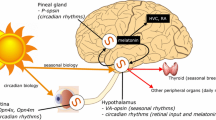Abstract.
Membrane leaves the rhabdom of Limulus photoreceptors either by transient shedding at dawn or throughout the day by light-driven shedding. We examined whether the light trigger for transient shedding and the light drive for light-driven shedding are localized properties of the illuminated photoreceptors or whether they are an array property of the retina. Four experiments were conducted during which the lateral eye was exposed to one of a variety of different illumination patterns for a day, fixed, dissected and cut into serial frozen sections. Immunocytochemistry with different antibodies to Limulus opsin and arrestin revealed the results of the two processes in a distinguishable way. Eyes stimulated with whole-eye illumination had both types of shedding or just light-driven shedding when transient shedding was blocked by cutting the optic nerve. Eyes exposed to whole-eye darkness had neither type of shedding. However, when only half of an eye was exposed to light, the dark half had the same kinds of shedding as the lighted half. We conclude that the signals to trigger or drive shedding must be communicated laterally from illuminated ommatidia to unilluminated ommatidia. Rhabdom shedding is an array property.
Similar content being viewed by others
Author information
Authors and Affiliations
Additional information
Electronic Publication
Rights and permissions
About this article
Cite this article
Warren, .D., Chamberlain, .S. Spatial control of rhabdom shedding in the lateral eye of the American horseshoe crab, Limulus polyphemus. J Comp Physiol A 188, 371–379 (2002). https://doi.org/10.1007/s00359-002-0311-0
Accepted:
Issue Date:
DOI: https://doi.org/10.1007/s00359-002-0311-0




